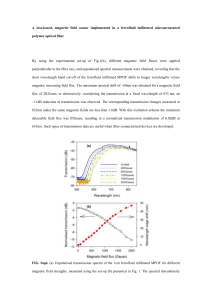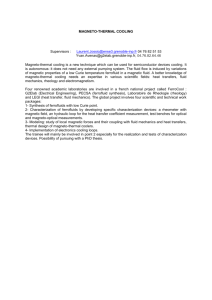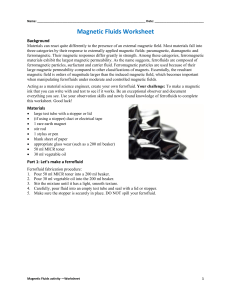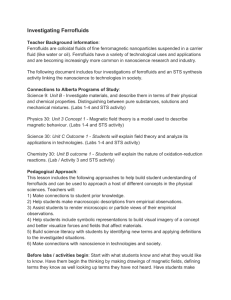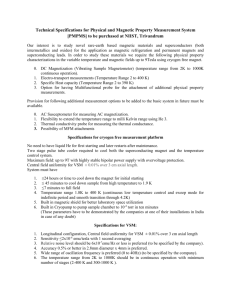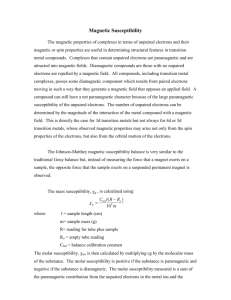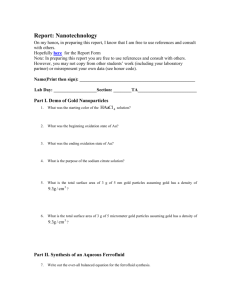Purpose: Introduction:
advertisement
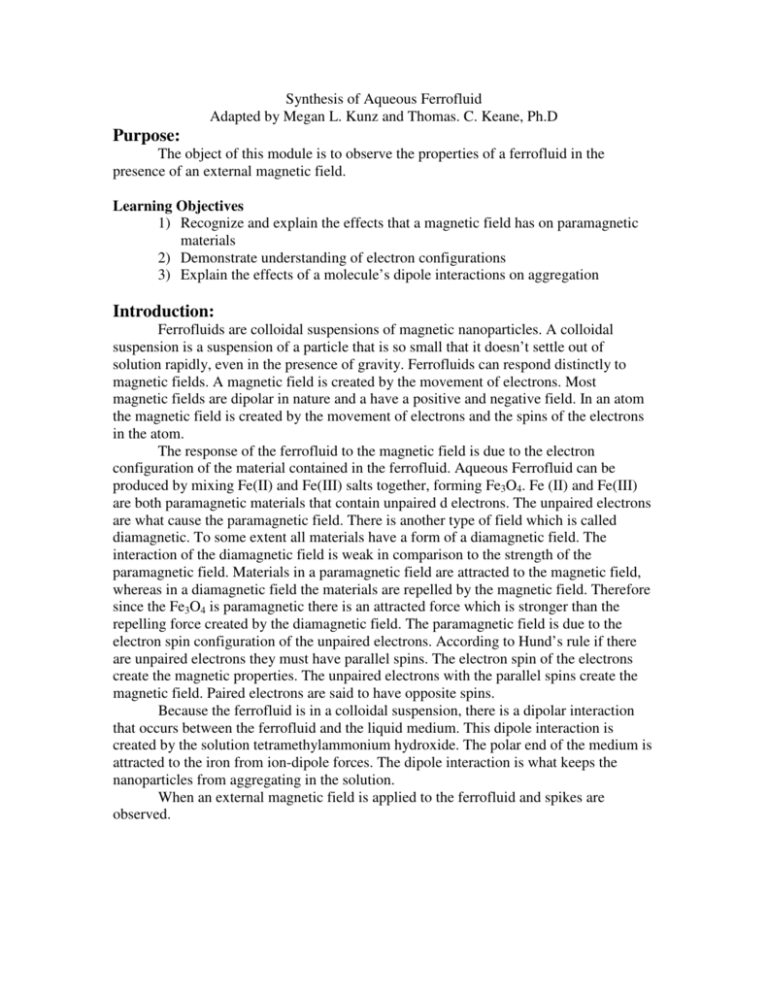
Synthesis of Aqueous Ferrofluid Adapted by Megan L. Kunz and Thomas. C. Keane, Ph.D Purpose: The object of this module is to observe the properties of a ferrofluid in the presence of an external magnetic field. Learning Objectives 1) Recognize and explain the effects that a magnetic field has on paramagnetic materials 2) Demonstrate understanding of electron configurations 3) Explain the effects of a molecule’s dipole interactions on aggregation Introduction: Ferrofluids are colloidal suspensions of magnetic nanoparticles. A colloidal suspension is a suspension of a particle that is so small that it doesn’t settle out of solution rapidly, even in the presence of gravity. Ferrofluids can respond distinctly to magnetic fields. A magnetic field is created by the movement of electrons. Most magnetic fields are dipolar in nature and a have a positive and negative field. In an atom the magnetic field is created by the movement of electrons and the spins of the electrons in the atom. The response of the ferrofluid to the magnetic field is due to the electron configuration of the material contained in the ferrofluid. Aqueous Ferrofluid can be produced by mixing Fe(II) and Fe(III) salts together, forming Fe3O4. Fe (II) and Fe(III) are both paramagnetic materials that contain unpaired d electrons. The unpaired electrons are what cause the paramagnetic field. There is another type of field which is called diamagnetic. To some extent all materials have a form of a diamagnetic field. The interaction of the diamagnetic field is weak in comparison to the strength of the paramagnetic field. Materials in a paramagnetic field are attracted to the magnetic field, whereas in a diamagnetic field the materials are repelled by the magnetic field. Therefore since the Fe3O4 is paramagnetic there is an attracted force which is stronger than the repelling force created by the diamagnetic field. The paramagnetic field is due to the electron spin configuration of the unpaired electrons. According to Hund’s rule if there are unpaired electrons they must have parallel spins. The electron spin of the electrons create the magnetic properties. The unpaired electrons with the parallel spins create the magnetic field. Paired electrons are said to have opposite spins. Because the ferrofluid is in a colloidal suspension, there is a dipolar interaction that occurs between the ferrofluid and the liquid medium. This dipole interaction is created by the solution tetramethylammonium hydroxide. The polar end of the medium is attracted to the iron from ion-dipole forces. The dipole interaction is what keeps the nanoparticles from aggregating in the solution. When an external magnetic field is applied to the ferrofluid and spikes are observed. Materials: 2M HCl 2.0 M FeCl2 (H2O)4 1.0 M FeCl3(H2O)6 1.0 M NH3 in water 25% tetramethylammonium hydroxide in water. Cow magnetic Wash bottles Gloves (a must, ferrofluid will stain hands) Stir bar and magnetic stirrer Separatory funnel Procedure: 1) 2) 3) 4) 5) 6) 7) 8) 9) Set up a magnetic stirrer on a ring stand in a fume hood. Then set up a separatory funnel or burette above the magnetic stirrer. As shown to the left. In a 100 ml beaker add 4.0 ml of 1M FeCl3 solution and 1.0 ml of 2M FeCl2 solution. Add a magnetic stir bar and begin stirring. Place 50 ml of aqueous 1.0 M NH3 into the separatory funnel. With continuous stirring add the 1M aqueous NH3 dropwise over a five minute period. (There will first be a brown precipitate that forms and then the solution will form black magnetic precipitate). CAUTION: NH3 is a strong base even though it is dilute. Immediately turn off the stirrer after all of the NH3 is added. Then using a strong magnet work the stir bar up the side of the container then with gloves or thongs remove the stir bar from the beaker. Allow the magnetite to settle to the bottom of the beaker. Use a strong magnet at the bottom of the beaker to speed up the process. Once the magnetite is at the bottom of the beaker, decant (pour off) the clear liquid. To aid in keeping the remainder of the magnetite in the bottom of the beaker, keep the cow magnet on the bottom of the beaker while pouring off the liquid. With a few squirts from a wash bottle of dH2O transfer the solid into a plastic weigh boat. Use the magnet to attract the ferrofluid to the bottom of the weigh boat and discard the clear liquid. Rinse the ferrofluid three times with water. Using the same decanting technique. Do not remove all of the water, because a solid will form. 10) 11) 12) 13) Once the washing is finished add, with a pasture pipette, 12ml of 25 % tetramethylammonium hydroxide. Gently stir the solution with a glass rod for at least a minute to suspend the ferrofluid. Use a strong magnet to attract the ferrofluid to the bottom of the weigh boat and pour off and discard the dark liquid. Move the magnet around again and pour off any liquid. Repeat this process continually until the ferrofluid starts to spike in the presence of the magnet. Discussions: 1) Write out the electron configuration for the Fe(II) and Fe(III) ions. Also write out the orbital diagram to show the unpaired electrons using the high spin case along with Hund’s rule. 2) Describe what happens when the ferrofluid is in the presence of the magnet, and also what happens when the magnet is removed. 3) Explain in your own words, on a molecular level, why the observations in question 2 occurred. 4) Explain the purpose of adding the NH3 dropwise, speculate on what might occur if the NH3 was added all at once. 5) What is the purpose of the tetramethylammonium hydroxide in the reaction? 6) Balance the following chemical reaction __ FeCl3 + __ FeCl2 + __ NH3 + __ H2O → __ Fe3O4 + __ NH4Cl 7) According to the balanced reaction which ion is in the greatest supply in the Fe3O4: Fe (II) or Fe (III). Citations Lisensky, G ( 2007, September, 25). Synthesis of Aqueous Ferrofluid. Interdisciplinary Education Group, Retrieved March 6, 2008, from http://mrsec.wisc.edu/Edetc/nanolab/ffexp/index.html. American Chemical Society, (1998). Ferrofluid. Chemistry comes alive , Retrieved April 15, 2008, from http://jchemed.chem.wisc.edu/jcesoft/cca/cca2/MAIN/FEFLUID/CD2R1.HTM Tolbert, Sarah (2007). How to Make a Ferrofluid. UCLA, Retrieved April 15, 2008, from http://voh.chem.ucla.edu/classes/Magnetic_fluids/pdf/Ferrofluid%20Student%20 Manual%202005.doc 1) Write out the electron configuration for iron metal and the Fe(II) and Fe(III) ions. Also write out the orbital diagram to show the unpaired electrons using the high spin case along with Hund’s rule. Fe Fe II Fe III [Ar].3d6.4s2 [Ar].3d6 [Ar].3d5 1s2 2s22p63s23p64s03d5 1s2 2s22p63s23p64s03d5 • 1s2 2s2p6 3s2p6d6 4s2 2) Describe what happens when the ferrofluid is in the presence of the magnet, and also what happens when the magnet is removed. When the magnet is applied the ferrofluid forms spikes, when it is removed it goes back to liquid. 3) Explain in your own words, on a molecular level, why the observations in question 2 occurred. Because of the unpaired electrons in the sample, the ferrofluid is paramagnetic which means it is attracted to a magnetic field. When the magnet is applied the spins align and they cause the liquid to spike and be attracted to the surface of the magnet. 4) Explain the purpose of adding the NH3 dropwise, speculate on what might occur if the NH3 was added all at once. The substance would aggregate together and clump. The substance would folliculate. 5) What is the purpose of the tetramethylammonium hydroxide in the reaction? The tetramethyl ammonium hydroxide in the reaction serves to is that it create a dipole interaction with the iron molecules and it keeps the molecules from aggregating. 6) Balance the following chemical reaction _2_ FeCl3 + _1_ FeCl2 + _8_ NH3 + _4_ H2O → _1_ Fe3O4 + _8_ NH4Cl 7) According to the balanced reaction which ion is in the greatest supply in the Fe3O4: Fe (II) or Fe (III). Fe (III) Pre-lab Materials Preparation of FeCl2(H2O)4 solution Dissolve 19.9 grams of FeCl2(H2O)4 in 50 ml of 2M HCl. Preparation of FeCl3(H2O)6 solution Dissolve 54.1 grams of FeCl3(H2O)6 in 200 ml of 2M HCl.
